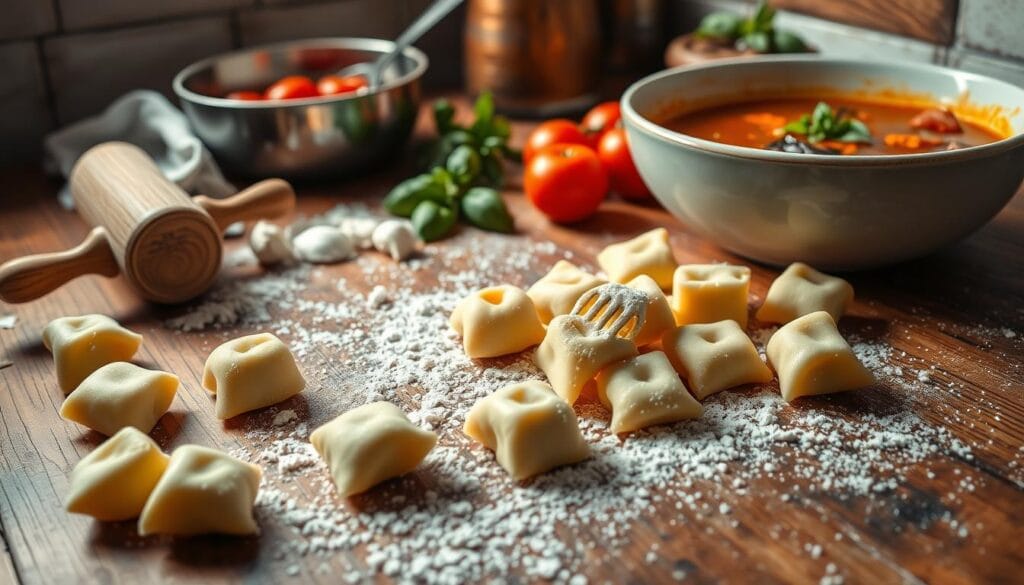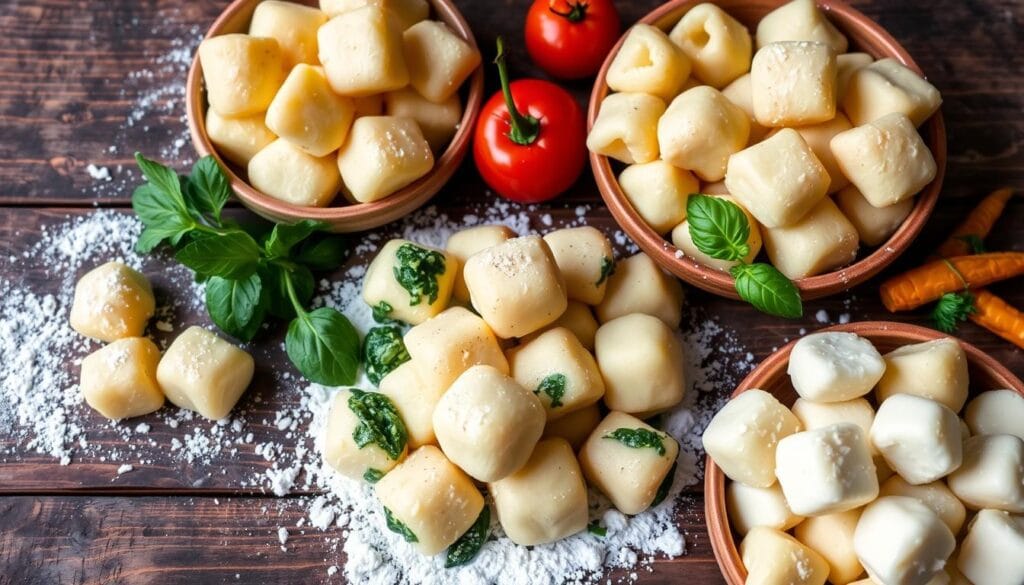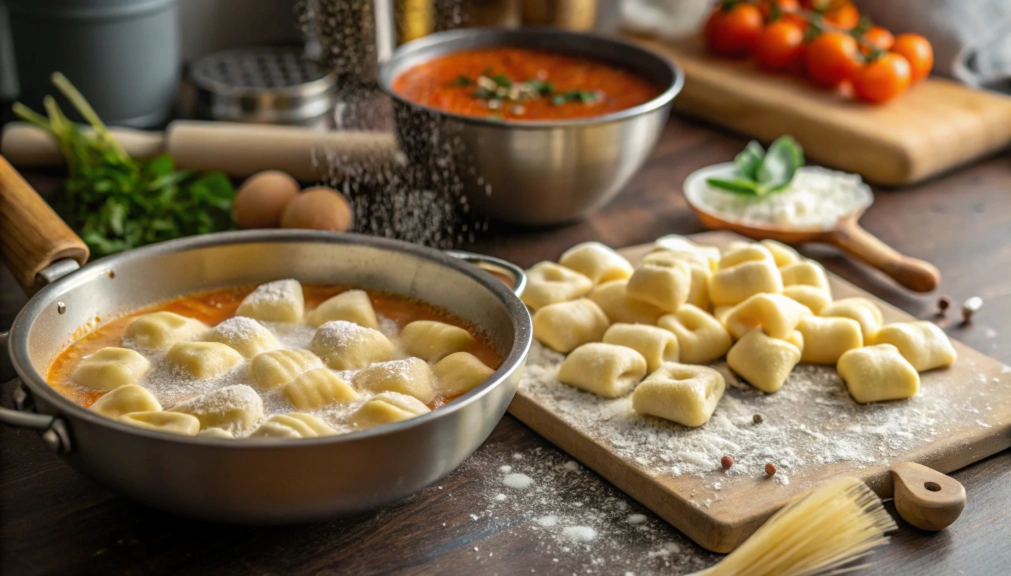Adding gnocchi to soups can make them even more delicious. But, many wonder if they should cook the gnocchi first or add it straight to the soup. We’ll share the best ways to add gnocchi to your soups, giving you expert advice for perfect results.

Table of Contents
Understanding Gnocchi Basics and Their Role in Soup Making
Gnocchi, the tender Italian dumplings made from potato, ricotta, or other bases, are an excellent addition to many soups. They provide a satisfying, filling element, and understanding their properties is essential for optimal preparation. For a detailed look at classic recipes, you might enjoy this guide to Chicken Gnocchi Soup, which offers a flavorful way to explore gnocchi’s versatility in soups.
Types of Gnocchi Available for Soups
There are many gnocchi options for soups. The classic choice is potato gnocchi, made from mashed potatoes, flour, and eggs. But you can also try ricotta gnocchi for a lighter taste. For a gluten-free option, consider semolina or sweet potato gnocchi.
Common Misconceptions About Gnocchi Preparation
Many think gnocchi need to be cooked before adding them to soup. But, most gnocchi can cook right in the broth. This makes the soup preparation easier and ensures a perfect mix of flavors and textures.
Some believe gnocchi become mushy in soup. But, if cooked correctly, they can stay firm in a flavorful broth. Just remember to use the right cooking time and method.

Learning about gnocchi’s versatility can open up new possibilities in soup making. Try different gnocchi types and soups to find your favorite dish.
Do You Cook Gnocchi Before Adding to Soup?
There’s a big debate on whether to cook gnocchi before adding them to soup. The answer depends on gnocchi’s unique properties and how they mix with the soup base.
Cooking gnocchi before adding them to soup has its benefits. It helps them keep their shape and texture in the hot liquid. You can also control how done they are, avoiding mushiness. Plus, it can thicken the soup, making it more filling.
But, adding uncooked gnocchi to the soup is quicker and easier. They cook in the broth, soaking up flavors and blending well. This is great when you’re in a hurry or want a lighter soup.
Choosing to cook gnocchi before or during soup making depends on what you like. Try both ways to see which fits your cooking style and dish best.
“The key is to find the right balance between the gnocchi’s texture and the soup’s overall consistency.”
Whether you pre-cook or add gnocchi straight to the soup, watch the cooking time. Make sure they’re fully cooked before serving. With some trial and error, you’ll find the best way to prepare gnocchi soup for your taste.
If you’re experimenting with different soup combinations, check out these tips for how to add raw chicken to soup. Proper timing and heat management ensure both the chicken and gnocchi cook to perfection without affecting the soup’s consistency.
The Perfect Timing: Cook Gnocchi Before Adding to Soup
Adding gnocchi to your soup at the right time is key. It helps get the perfect texture and consistency. You want the gnocchi to cook just right, without becoming mushy or falling apart.
For inspiration on combining flavors, consider exploring Olive Garden’s signature soups. These recipes demonstrate the perfect balance of broth, ingredients, and cooking techniques that elevate gnocchi-based dishes to restaurant-quality.
Signs Your Gnocchi is Perfectly Cooked
When gnocchi are cooked just right, they feel light and keep their shape. Here’s how to tell if they’re done:
- The gnocchi should float to the surface of the simmering broth.
- They should have a slightly firm, al dente bite when tested with a fork.
- The outer layer should be smooth and glossy, without any cracks or dryness.
Avoiding Common Timing Mistakes
Timing is everything when adding gnocchi to your soup. Here are some common mistakes to avoid:
- Overcooking: Adding the gnocchi too early can make them waterlogged and mushy.
- Undercooking: Adding them too late can leave a raw, doughy center.
- Dropping temperature: Cold gnocchi can lower the soup’s temperature, affecting the soup consistency.
By watching the cooking time and temperature, you can make sure your gnocchi are cooked just right. This way, they blend perfectly into the soup for a great meal.
Direct vs. Pre-cooking Method: Which Works Best?-Cook Gnocchi Before Adding to Soup
When adding gnocchi to your soup, you can choose between two methods: direct or pre-cooking. Each method has its own benefits and drawbacks. Knowing the differences helps you pick the best way for your recipe and taste.
The Direct Approach
The direct method means adding raw gnocchi straight to the hot soup. It’s quick and easy, skipping the extra step of cooking gnocchi first. The gnocchi soak up the soup’s flavors and textures.
The direct method’s advantages are:
- It’s faster and more efficient.
- Gnocchi stays light and fluffy.
- Perfect for adding gnocchi at the last minute.
The Pre-cooking Approach
The pre-cooking method boils gnocchi in salted water until they float. Then, they’re added to the soup. This method makes sure gnocchi are cooked well before they’re in the soup.
Pre-cooking gnocchi has its benefits:
- It ensures gnocchi are cooked evenly.
- It helps gnocchi stay firm and not mushy.
- It gives you control over gnocchi’s texture.
Choosing between direct and pre-cooking depends on your taste, recipe, and desired texture. Try both methods to see which works best for your gnocchi soup.
| Direct Method | Pre-cooking Method |
|---|---|
| Faster cooking process | Ensures consistent cooking of gnocchi |
| Gnocchi retains light, fluffy texture | Minimizes risk of gnocchi falling apart or becoming mushy |
| Convenient for last-minute additions | Allows for more control over gnocchi texture and doneness |
“Experiment with both techniques to find the approach that works best for your gnocchi soup creations.”
Temperature Control: Key to Perfect Gnocchi Soup
Getting the perfect gnocchi soup is all about temperature. Whether it’s a classic Italian dish or a modern twist, knowing the right heat is key. Here are some tips to help you master temperature control for your gnocchi soup.
Optimal Heat Levels for Cooking
The secret to perfectly cooked gnocchi is the right temperature. The soup should simmer between 195°F and 205°F (91°C and 96°C). This keeps the gnocchi light and fluffy.
If the soup is too hot, the gnocchi can fall apart. Too cold, and they stay doughy. Watch the temperature closely to keep your gnocchi just right.
Managing Soup Consistency
The soup’s consistency is also crucial. It should be thick and creamy, with gnocchi evenly spread. To keep it this way, watch the heat and moisture.
- Adjust the heat to avoid too thick or thin soup.
- Add hot broth or water if it gets too thick.
- Simmer gently to meld flavors and cook gnocchi without overcooking.
By focusing on temperature and consistency, your gnocchi soup will be delicious and look great. The dumplings will be perfectly in the broth.
“Mastering the temperature and consistency of your gnocchi soup is the key to creating a truly memorable dish.”
Preventing Gnocchi from Becoming Mushy in Soup-Cook Gnocchi Before Adding to Soup
Keeping gnocchi just right in soup is a challenge. No one likes a bowl of mushy gnocchi. Luckily, there are ways to keep your gnocchi texture perfect in soup quality.
Start with your cooking techniques. If gnocchi are undercooked, they become gummy. Overcooking makes them fall apart. Cook them until they float, then add them to your soup.
The soup base matters too. Tomato soups are acidic and can break down gnocchi fast. Choose a creamier broth that complements the gnocchi texture.
Timing is also key. Add gnocchi just before serving. This way, they heat up without getting mushy. If you must wait, cook gnocchi separately and add them to each bowl.
By following these tips, your gnocchi texture will stay firm and tasty. With a bit of care, your soup will have perfect flavors and textures.
Best Soup Bases for Gnocchi Dishes-Cook Gnocchi Before Adding to Soup
Pairing gnocchi with the perfect soup base opens up a world of flavors. From classic Italian dishes to modern twists, the right soup can make your gnocchi dishes stand out.
Classic Italian Soup Combinations
Traditional Italian cuisine pairs gnocchi with a rich tomato soup. The dumplings and tomatoes create a perfect balance of flavors. Another favorite is gnocchi in a creamy broth, like Parmesan or Gorgonzola.
Modern Fusion Options
Want to try something new? Gnocchi can be paired with many soups. Try them in vegetable soups, chicken noodle soups, or even a spicy Thai lemongrass and coconut milk soup.
| Soup Base | Flavor Profile | Complementary Gnocchi Dishes |
|---|---|---|
| Tomato | Acidic, savory | Classic Italian gnocchi soup |
| Creamy Cheese | Rich, indulgent | Gnocchi in Parmesan or Gorgonzola broth |
| Vegetable | Earthy, nourishing | Gnocchi in a hearty minestrone or roasted vegetable soup |
| Thai Lemongrass-Coconut | Aromatic, spicy | Gnocchi in a Thai-inspired soup |
Choosing the right soup base is key. It lets the gnocchi’s texture and flavor take center stage. This way, you can make a standout soup recipe that celebrates Italian cuisine.
Next time you want a comforting soup, try adding gnocchi. The possibilities are endless!
Professional Tips for Restaurant-Style Gnocchi Soup
Make your gnocchi soup restaurant-quality with these tips. Start by cooking your gnocchi in a skillet with olive oil or butter. This step gives them a crispy outside and a soft inside. It’s a simple trick that makes your soup stand out.
For a gourmet touch, add Parmesan cheese or truffle oil to your soup. These toppings give your dish a fancy, restaurant-like feel. Also, keep the soup at the right temperature. This ensures your gnocchi are always tender and perfectly cooked.
Try using different soup bases to match the gnocchi’s rich flavor. Swap the usual chicken or vegetable broth for creamy mushroom or roasted tomato. You can even use lemongrass-infused stock. Let your creativity shine in the kitchen to explore endless possibilities.
FAQ-Cook Gnocchi Before Adding to Soup
Do you cook gnocchi before adding to soup?
You can cook gnocchi in the soup or pre-cook it. The choice depends on the recipe and the texture you want.
How many calories are in the chicken and gnocchi soup from Olive Garden?
Olive Garden’s chicken and gnocchi soup has about 330 calories per serving. This includes the chicken, gnocchi, and broth.
What are the four soups at Olive Garden?
Olive Garden’s four signature soups are: Minestrone, Pasta e Fagioli, Chicken & Gnocchi, and Zuppa Toscana.
How do I add raw chicken to soup?
To add raw chicken to soup, just put the chicken pieces in the simmering broth. Cook until the chicken is done, about 10-15 minutes. Keep the soup at a gentle simmer to cook the chicken evenly.
Conclusion
Adding gnocchi to soups is an easy way to elevate their flavor and heartiness. Whether you choose to cook gnocchi before adding to soup or opt for the direct method, both techniques can yield delicious results when executed properly. Pre-cooking gnocchi ensures they maintain their texture and prevents them from becoming mushy, especially in creamier or acidic soups. This method also gives you greater control over the consistency of your dish, making it ideal for creating restaurant-quality gnocchi soup at home.
Remember to manage temperature, timing, and soup consistency to achieve a perfectly balanced dish. Experiment with various soup bases and toppings to find your favorite combinations. By following these tips, you’ll master the art of gnocchi soup preparation and create meals that are both satisfying and impressive.
For the best results, Cook Gnocchi Before Adding to Soup to ensure a delightful and well-textured dining experience.

